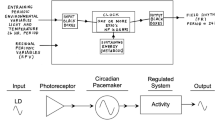Summary
The hypothesis that bilaterally redundant, and mutually coupled circadian pacemakers are located near the lobula of the optic lobes of the cockroach,Leucophaea maderae, was investigated in a series of lesion experiments.
-
1.
Following removal of one optic lobe electrolytic lesions near the lobula in the dorsal 1/3 of the remaining lobe had no effect on the activity rhythm or its entrainment to a light cycle. Lesions in the ventral 2/3 of the lobula region either had no effect or resulted in aperiodic activity (Figs. 3, 4).
-
2.
In animals in which one optic lobe was neurally isolated from its (ipsilateral) compound eye by section of the optic nerve, lesions near the lobula in the dorsal 1/3 of the contralateral lobe had no effect on entrainment of the rhythm. In contrast, lesions in the ventral 2/3's of the lobe, frequently, resulted in loss of entrainment (Figs. 5, 6, 7). Following loss of entrainment, the average freerunning period (\(\bar \tau = 24.03 \pm 0.26 h\)) was longer than that of intact animals (\(\bar \tau = 23.73 \pm 0.2 h\)).
-
3.
In animals with one cut optic nerve, electrolytic or surgical lesions in the ipsilateral optic lobe, intended to destroy the known monosynaptic connections between the two lobes, had no effect on entrainment or on freerunning period (Figs. 9, 10, 11).
These data collectively support the hypothesis that (a) bilaterally paired pacemakers in the optic lobes are coupled and mutually accelerate each other via a polysynaptic pathway; and (b) that entrainment of each pacemaker by its contralateral eye is mediated by this pathway.
Similar content being viewed by others
References
Block, G.D., Page, T.L.: Circadian pacemakers in the nervous system. Ann. Rev. Neurosci., in press (1978)
Brady, J.: How are insect circadian rhythms controlled? Nature223, 781–784 (1969)
Brady, J.: The search for the insect clock. In: Biochronometry (ed. M. Menaker), pp. 517–524. Washington, D.C.: National Academy of Sciences 1971
Menaker, M.: Aspects of the physiology of circadian rhythmicity in the vertebrate central nervous system. In: The neurosciences: Third study program (eds. F.O. Schmitt, F.G. Worden), pp. 479–489. Cambridge, Mass.: MIT Press 1974
Nishiitsutsuji-Uwo, J., Pittendrigh, C.S.: Central nervous system control of circadian rhythmicity in the cockroach. II. The pathway of light signals that entrain the rhythm. Z. vergl. Physiol.58, 1–13 (1968a)
Nishiitsutsuji-Uwo, J., Pittendrigh, C.S.: Central nervous control of circadian rhythmicity in the cockroach. III. The optic lobes, locus of the driving oscillation? Z. vergl. Physiol.58, 14–46 (1968b)
Page, T.L., Caldarola, P.C., Pittendrigh, C.S.: Mutual entrainment of bilaterally distributed circadian pacemakers. Proc. nat. Acad. Sci.74, 1277–1281 (1977)
Pittendrigh, C.S.: Circadian rhythms and the circadian organization of living systems. Cold Spr. Harb. Symp. quant. Biol.25, 159–182 (1960)
Pittendrigh, C.S.: Circadian oscillations in cells and the circadian organization of multicellular systems. In: The neurosciences: Third study program (eds. F.O. Schmitt, F.G. Worden), pp. 437–458. Cambridge, Mass.: MIT Press, 1974
Pittendrigh, C.S., Daan, S.: A functional analysis of circadian pacemakers in nocturnal rodents. I. The stability and lability of spontaneous frequency. J. comp. Physiol.106, 223–252 (1976a)
Pittendrigh, C.S., Daan, S.: A functional analysis of circadian pacemakers in nocturnal rodents. V. Pacemaker structure: a clock for all seasons. J. comp. Physiol.106, 333–355 (1976b)
Roberts, S.K.: Photoreception and entrainment of cockroach activity rhythms. Science148, 958–959 (1965)
Roberts, S.K.: Circadian rhythms in cockroaches. Effects of optic lobe lesions. J. comp. Physiol.88, 21–30 (1974)
Roth, R.L., Sokolove, P.G.: Histological evidence for monosynaptic connections between the optic lobes of the cockroach.Leucophaea maderae. Brain Res.87, 23–39 (1975)
Sokolove, P.G.: Localization of the cockroach optic lobe circadian pacemaker with microlesions. Brain Res.87, 13–21 (1975)
Author information
Authors and Affiliations
Additional information
I thank Dr. C.S. Pittendrigh for his support and encouragement throughout the course of these experiments, and Dr. Gene D. Block and Mr. Carl Johnson for reading an early version of the manuscript. I also thank Diana K. Page for aid in preparation of the figures. Support for this research was provided by a National Institute of Mental Health Grant (MH21114-05) and a National Institute of Aging Grant (AG0004-02) to C.S. Pittendrigh. The author was supported by National Institute of Mental Health Training Grant (MH8304-11).
Rights and permissions
About this article
Cite this article
Page, T.L. Interactions between bilaterally paired components of the cockroach circadian system. J. Comp. Physiol. 124, 225–236 (1978). https://doi.org/10.1007/BF00657054
Accepted:
Issue Date:
DOI: https://doi.org/10.1007/BF00657054




